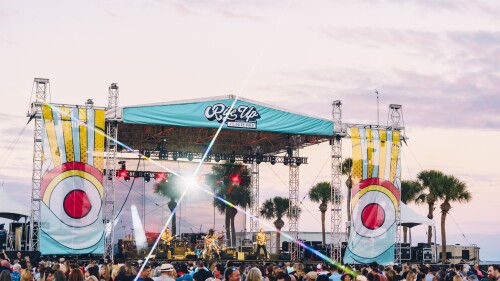It’s time for a history lesson, TBAY.
Following our look at the Roaring 20s, it’s time to move on to the next decade. Both Tampa and St. Pete underwent significant change + challenges following the impacts of the Great Depression in 1929.
Despite economic hardship, job insecurity, and the growing threat of global conflict, our area continued to grow + emerged with hope for a brighter future.
Population
From 1920 to 1930, Tampa’s population roughly doubled to 101,000, and St. Pete’s almost tripled, ending the decade with 40,000 people calling the Burg home.
However, this trajectory slowed. Tampa’s population grew by only ~7,000 people between 1930 and 1940, marking a significant deceleration. The Burg’s slowdown was not as drastic, with ~20,000 more people still making the move by the end of the 30s.
St. Pete’s continued rise may be owed to the engineering marvel of the Gandy Bridge, which opened in the mid-1920s + made travel to the Sunshine City a far less daunting prospect.

People unloading bananas in Tampa, 1930.
Photo via Florida Memory
In this economy?
The Great Depression decimated every local economy, and Tampa was no exception. The 1920s saw the Cigar City’s cigar production line accelerate to new heights, peaking in 1929 with 500+ million rolled. But there was an immediate decline. Just four years later in 1933, ~42% fewer cigars made it out of the factories.
To steady the ship in the Big Guava, Robert E. Lee Chancey was elected mayor in 1931. To balance the books, Chancey slashed budgets, including $100,000 from the police and fire department, equivalent to ~$2 million in 2024. Despite his best efforts, he borrowed $750,000 — roughly $15 million in today’s money — to steer Tampa through the Great Depression.
A tip for the iced-Burg
St. Pete needed similar help to navigate murky financial waters. The 20s saw an explosion of infrastructure development, with the likes of the Vinoy + Don CeSar hotels, the Coliseum, the Shuffleboard Club, the History Museum, and the Florida Theater all opening their doors. As with many parts of the country, 1929 ground construction to a halt.
It was the 1933-elected Franklin D. Roosevelt’s “New Deal” which revived St. Pete’s infrastructure ascendancy. According to the Tampa Bay Times, the Burg received an amount equivalent to ~$22 million today in federal funds. The US Coast Guard Station St. Petersburg opened in 1933, and the St. Petersburg Tennis Club moved to Bartlett Park in 1935. Most notably, construction finished on City Hall in 1939 — the same city hall in use today.

This 1941 postcard shows St. Pete’s newly-built City Hall in all its glory.
Photo via Florida Memory
The cultural landscape
As the woes of the Great Depression eased, and tourists began arriving more readily through the middle of the decad, the Tampa Bay area’s cafeteria culture thrived through the colder months. Much like today, November saw an influx of snowbirds arriving for winter.
At cafeterias, diners queued with trays, and were served inexpensive hearty meals with largely Southern influence. Fried chicken, collard greens, and cornbread were all staples of TBAY’s scene, and diners could enjoy the delicacies inside ornate rooms. “Cafeterias provided good people in hard times a touch of class,” according to the Tampa Bay Times.
And in 1930, the first full-length talking picture filmed in Florida was released to the world. “Hell Harbour” is set in the Caribbean, but was filmed in Tampa’s Rocky Point area because of its tropical + geographic resemblance.

The University of Tampa, 1937.
Photo via Hillsborough County Public Libraries
Open for business
As for one of Tampa’s most iconic buildings, the former Tampa Bay Hotel became the site of the University of Tampa in 1933. The buildings were left dormant in 1931 after a Depression-influenced decline in tourism.
Here’s a fun one. Three St. Pete sisters opened a bank along Central Avenue in 1935. Cornelia, Elsie, and Ilonka Somp founded the St. Petersburg Federal Savings and Loan Association at the corner of Central Avenue and Fourth Street, before expanding to 556 Central Ave. in 1941, where the building remains today. The business was eventually sold in 1987.
Another of TBAY’s famous attractions also opened its green-tinged doors in the 1930s: Sunken Gardens. The Turner family opened their picturesque St. Pete property to the public in 1936, at an initial price of 15 cents per visit.

Find the mural at 2015 E. 7th Ave., Tampa.
Photo by City of Tampa
The outbreak of war
In the latter part of the decade, fascism and Nazism were rising across the world. In protest, women marched through Ybor City to voice their discontentment at the changing political tide. A reported ~5,000 protesters attended, who are now honored in both a mural + plaque, both located near the Columbia Restaurant.
As the world sat on the brink of World War II, Tampa Bay prepared to do its part. Mac Dill Air Force Base, originally called Southeast Air Base Tampa, was established on May 24, 1939. Construction began on September 6, 1939, just five days after Hitler’s invasion of Poland led to a declaration of war from Britain and France. Flying operations out of Tampa began in 1941, and the base was used throughout the conflict to train those heading to fight in European skies.
In short, the 1930s were somewhat topsy-turvy. The decade began in a deep financial Depression, and ended with the onset of what would become a brutal conflict. Despite the wide-ranging nature of these global events, their significance was felt across TBAY, as our area looked toward an uncertain, unstable, and unharmonious future.
We’d love to hear any memories from readers about the 1930s, or any stories from loved ones. Let us know.











